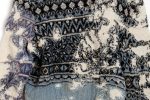
There’s an othertimely resourcefulness to textile artist Celia Pym, trained nurse turned professional darner: “Sewing is still healing, I suppose,” she says. The Royal College graduate first caught the fashion gaze with her mesmerising shortlisted entry for the 2017 Loewe Craft Prize – a tenderly darned Norwegian sweater, rescued from disintegration and reconfigured into a rhapsody of layered blues. The sweater was taken from a recycling plant, and was “the biggest repair job I’ve ever done,” with overlaid stitches decorating the Fair Isle pattern like fresh-fallen snow. “Wear is such a drawn-out process. Slow. It’s like looking in a mirror at an ageing face,” she says. Pym shuns the concept of invisible repairs as the sartorial equivalent of Botox: “Masking, but never the same as the original. It seems too apologetic.”
Pym is certainly uncompromising (she once spent nine months knitting her way around Japan) and craft is her vocation. Her passion for renewing the lifespan of clothes harks to the make-do-and-mend public initiative of World War II, but in 2018’s uncertain climate, she sees her focus as being more on “emotional sustainability”. “It’s less about a shortage of material or poverty; you can replace things very cheaply these days on the high street. The point is learning a survival skill, doing something creative,” she says from her home studio in Stoke Newington. Pym believes in being hands-on, exploring the tenderness and the invention required, and hosts mending workshops at a local haberdashery in her native east London. As Radio 4’s Women’s Hour craft prize finalist, she has also held an “open invitation” live exhibit at the Victoria & Albert Museum for the public to bring along their own items to be repaired. “Grief is often the story embedded in the clothes that people want to save,” she observes, “although someone did bring in pair of tights, bizarrely!”
“Grief is often the story embedded in the clothes that people want to save.”
Her first encounter with darning, Pym recalls, was watching her aunt mend the studio jumper belonging to her late uncle, also an artist – “the forearms heavy with repairs, echoing his body leaning over his work.” Her own repairs, often disruptively bright, are indelibly unique, whether working by commission or for her own artistic expression. “Clothing is so personal. And the act of repairing is the smallest gesture loaded with such love.” The aim of her work? “To make absence a whole again, but different, fresher.” Pym is using her old-school skill set to celebrate change; and that is pretty crafty indeed.

